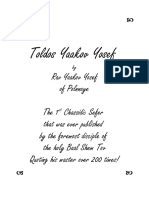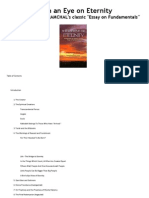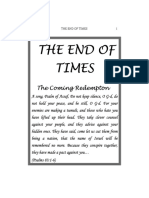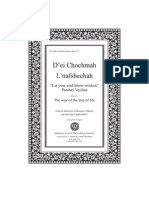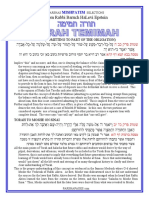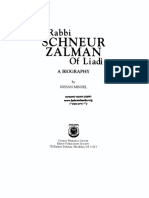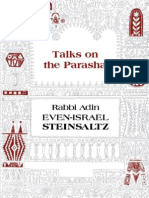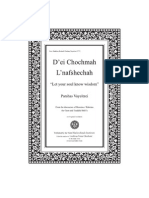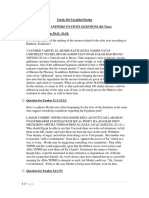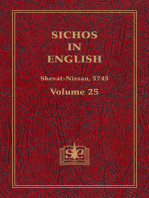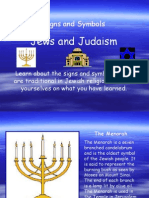Mitokh HaOhel: Haftarot
Mitokh HaOhel: Haftarot
Uploaded by
KorenPubCopyright:
Available Formats
Mitokh HaOhel: Haftarot
Mitokh HaOhel: Haftarot
Uploaded by
KorenPubCopyright
Available Formats
Share this document
Did you find this document useful?
Is this content inappropriate?
Copyright:
Available Formats
Mitokh HaOhel: Haftarot
Mitokh HaOhel: Haftarot
Uploaded by
KorenPubCopyright:
Available Formats
Prof.
Adina Levine Rydzinski
Ha arah for the First
Day of Rosh Ha-Shanah:
e Story of Chanah
and Divine Justice
he story of Chanah is a moving account of the power of prayer
that seems to t exactly where it is placed at the center of the Rosh
Ha-Shanah liturgy. e plot is not a new one, as it echoes the stories
of Sarah, Rivka, and Rachel in varying degrees there is the barren favored wife, a fertile rival, and an adoring husband who proves
.
While the text of the ha arah recounts simply that her rival would frequently anger her (Shmuel Aleph : ), the Midrash elaborates the multiple taunts of Peninah,
Elkanahs other wife. Rashi recounts that Peninah would say to Chanah, Did you
buy your older son a cloak today or your younger son a shirt? Other midrashim add
that Peninah would rise early and say to Chanah, Arent you going to get up and
wash your childrens faces so they can go to school? At midday, Peninah would say
Arent you preparing to welcome your children home from school? When they sat
Excerpted from "Mitokh HaOhel: Haftarot" (Maggid Books, 2011)
Mitokh Ha-Ohe vol 2 11 draft 06 balanced.indd 515
9/15/2011 6:59:24 AM
Haftarah for the First Day of Rosh Ha-Shanah
unsympathetic until the barren wife is ultimately remembered by God
and conceives a son. e narrative thus closely parallels the Torah portion that is read on Rosh Ha-Shanah when God remembers the barren
Sarah to give her a son and, as the Talmud recounts, both Sarah and
Chanah (as well as Rachel) were remembered on Rosh Ha-Shanah.
Yet, the story of Chanah rises above the accounts of the Matriarchs in the detail it provides with regard to Chanahs prayer and the
accompanying narrative of Elis misunderstanding and it serves as the
source of many of the laws of prayer. While Rivka summarily asked If
.
.
.
down to eat, Peninah would say to Elkanah Give this son of mine his portionYou
did not give that son of mine his portion, thereby constantly reminding Chanah of
her barren status (Pesikta Rabbati ). e Talmud, however, explains that Peninah
had righteous intentions and sought only to motivate Chanah to pray (Bava Batra
a), a statement that is dicult to reconcile with other midrashim which state that
Peninah was punished and lost two children for every child that Chanah bore (Rashi
to Shmuel Aleph : ).
Elkanahs statement Am I not be er to you than ten sons? (Shmuel Aleph : )
is only slightly more comforting than Yaakovs exhortation Am I instead of God
who has withheld children from you? (Bereishit : ) and Avrahams request let
Yishmael live before you (Bereishit : ). e Malbim explains that Elkanah was
simply stating that he no longer expected Chanah to bear children and wished
to console her with his love as a substitute, since women are not commanded to
procreate however, such a sentiment instead prompted Chanah to rise up and
ask God for a son.
e Midrash recounts that Chanah was
years old when she conceived Shmuel
(Midrash Shmuel, ed. Buber, : ), making her the older than any of the Matriarchs
when they conceived, and the same age as Chava when she gave birth to Sheit
(Bereishit : ) and Yocheved when she gave birth to Moshe (Sotah a).
Bereishit : .
See Rosh Ha-Shanah b.
e narrative recounts that the High Priest Eli thought that Chanah was a drunkard
(Shmuel Aleph : ). is misunderstanding is somewhat perplexing given that
Chanah is interpreted to have prayed in the model fashion, and presumably Eli
was aware of the laws of prayer. See discussion in a for one interpretation of Elis
mistake (Cf. Maharsha, Rashi).
Indeed, R. Hamnuna exclaims How many important laws can be learned from
these verses relating to Chanah! (Berakhot a). ere is some debate, though, as
to whether the story of Chanah is the exclusive source for these laws, or simply one
possible source e.g., the Maharsha notes that these laws may also be derived from
other sources.
Excerpted from "Mitokh HaOhel: Haftarot" (Maggid Books, 2011)
Mitokh Ha-Ohe vol 2 11 draft 06 balanced.indd 516
9/15/2011 6:59:24 AM
Prof. Adina Levine Rydzinski
so, why is this me? and she went to seek Hashem during her struggle
to have children, this ha arah recounts the full text of Chanahs prayer,
both before and a er the birth of Shmuel. e Talmud also notes that
Chanah is the rst person to refer to God as Master of Legions an
epithet that merited her considerable reward and which has since
become part of our prayer lexicon. Additionally, the very form for
prayer is derived from this narrative that one who prays should direct
his/her heart toward God, and must enunciate the words rather than
simply think of the prayer, but must do so quietly so that the benediction is inaudible to others.
However, Chanahs prayer is not a simple supplication or an
importuning petition that one would imagine is encouraged on Rosh
Ha-Shanah. In fact, talmudic sources have infused Chanahs prayer
with a level of temerity, and a brazenness, that changes the tenor of the
prayer from one of entreaty to one of a challenge to Gods Divine justice. For instance, the Talmud recounts several objections that Chanah
levied against God, in which Chanah challenged the justice of her barrenness. e Talmud concludes that when the text states that Chanah
. Bereishit : .
. Chanahs song following the birth of Shmuel (Shmuel Aleph : ) contains elements of both gratefulness and praise for Hashem for having granted her a son, as
well as prophecy for the future of the Jewish people (Radak, Ralbag).
. Shmuel Aleph : .
.
e Midrash relates that because Chanah multiplied Gods legions by calling
Him Master of Legions, God responded in kind and multiplied Chanahs legions,
i.e. her grandchildren and great-grandchildren (Midrash Shmuel, ed. Buber, : ).
. See Berakhot b. Maharsha and Radak note that the text many times refers to God
as Master of Legions (e.g., Shmuel Aleph : ) but Chanah was the rst person to
employ this term.
. See Berakhot a. e Talmud explains that the text but her voice was not heard
(Shmuel Aleph : ) teaches that it is forbidden to raise ones voice during prayers
(Berakhot a). However, this only means that ones prayer should not be heard by
others; it should, though, be loud enough to be heard by oneself. (Shulchan Arukh,
Orach Chaim : ).
. One of these challenges was that Chanah asked Hashem what the purpose was of
her reproductive anatomy, if God had decreed that she be barren. See Berakhot b
and discussion in a for other challenges.
Excerpted from "Mitokh HaOhel: Haftarot" (Maggid Books, 2011)
Mitokh Ha-Ohe vol 2 11 draft 06 balanced.indd 517
9/15/2011 6:59:24 AM
Haftarah for the First Day of Rosh Ha-Shanah
prayed al Hashem literally, against God, that she had ung her
words upwards toward Heaven without the proper respect. Similarly,
the Midrash recounts that Chanah was punished for the content of her
prayer by adding super uous words to her prayer, Chanah shortened
Shmuels life to years. With such a censured context, the selection
of Chanahs prayer as the model in the liturgy of Rosh Ha-Shanah a
day devoted to prayer and repentance characterized by the recantation
that prayergets rid of evil decrees is extremely perplexing. While
Chanahs request was certainly granted she birthed the son that she
sought the level of criticism surrounding her prayer begs the question
as to why the story of Chanah serves as a model for prayer.
One particularly interesting challenge that Chanah raises in her
prayer is worthy of mention, as it both strengthens this question, and
may ultimately help provide a solution. In interpreting the double use
of the verb see in Chanahs statement if You will see (literally if see,
You will see) the suering of Your maidservant, the Talmud explains:
.
Said Chanah to Hashem, Master of the Universe, if You see [i.e.
heed my prayer], ne; and if not, You will see [by other means].
I will seclude myself in front of my husband Elkanah and because
I secluded myself they will have me drink the waters of the sotah
. Shmuel Aleph : .
. Berakhot b. The verse should have read el Hashem, i.e. to Hashem, and therefore
the use of the preposition al means against (Ralbag to Shmuel Aleph : ; but see
Radak [who states that el and al are interchangeable and both mean to]).
. Midrash Shmuel : questions the result of Chanahs lengthy prayer, and that of
lengthy prayer in general. Because Chanah said in Shmuel Aleph : and he will
abide there forever, Shmuels life was limited to forever, which in the Levitical
sense implies y years, since that is the end of the service of the Levites in the
Sanctuary, and Shmuel was two years old when he was brought to the Sanctuary
(see also Yalkut Meam Loez).
. Shmuel Aleph : . Instead of simply stating im tireh if You will see, Scripture
uses repetitive language, im raoh tireh if see, You will see.
Excerpted from "Mitokh HaOhel: Haftarot" (Maggid Books, 2011)
Mitokh Ha-Ohe vol 2 11 draft 06 balanced.indd 518
9/15/2011 6:59:24 AM
Prof. Adina Levine Rydzinski
[the suspected adulteress], and You will not make Your Torah
a fraud, as it states: If the womanbe guiltless, then she shall
conceive seed.
At face value, this passage seems to indicate that Chanah somehow
blackmailed God with making the Torah a fraud as part of her plea
for a child. Chanah threatened to become a sotah by seclusion, but not
to actually succumb to the sin of adultery, becoming the innocent sotah
that the Torah promises shall conceive seed thereby compelling
God, as it were, to grant her a child. Far from the epitome of supplication that ein lanu al mi le-hishaen ela el Avinu She-Bashamayim individuals have no recourse other than reliance on God, Chanah appears
to have believed that she had some power to enter into the sotah process,
and treat it as a form of self-help, through which she would be able to
conceive her son by other means if God would not readily accede to
her request. In negotiation theory terms, Chanah had a
, an
alternative to a negotiated agreement, and therefore was not at the
total mercy of God.
e diculties inherent in Chanahs threat are numerous. Most
fundamentally, God is the same One who had promised that the cleared
sotah woman shall conceive seed and obviously, therefore, He has
the ability to revoke that promise in situations where the conception is
not deserving. To threaten the Omnipotent with inconsistency tears at
the boundaries of credibility God can easily carve out exceptions in
the same way that He created the rule. In fact, the baraita itself foresaw Chanahs threat that all barren women would simply choose to
. Berakhot b (quoting Bemidbar : ).
. See discussion in a as to whether even the exonerated sotah can fully be termed
innocent.
.
is a term coined by Roger Fisher and William Ury, and which stands for
best alternative to a negotiated agreement. It is a critical tool for the successful
negotiator as it arms the negotiator with the ability to simply walk away from the
negotiation with an alternative remedy. See Roger Fisher and William Ury. Ge ing
to Yes: Negotiating Agreement Without Giving In. (New York: Penguin Books,
),
.
. Indeed, the exception for the unworthy played out in the converse: the sotah waters
would not work if the cuckold himself had been unfaithful (Sotah a).
Excerpted from "Mitokh HaOhel: Haftarot" (Maggid Books, 2011)
Mitokh Ha-Ohe vol 2 11 draft 06 balanced.indd 519
9/15/2011 6:59:24 AM
Haftarah for the First Day of Rosh Ha-Shanah
undergo the sotah process and therefore R. Akiva maintains that the
only blessing that would emerge for the innocent sotah is that her conceptions would improve, and not that she now would be able to conceive
if heretofore she was unable. According to R. Akiva, then, the double
use of the verb see is simply the Torah speaking colloquially, and not
that Chanah leveraged any such threat against God.
However, according to R. Yishmael, who maintains that the
sotah process did result in newfound fertility for the guiltless woman,
it is necessary to understand the rationale behind Chanahs threat. Fundamentally, Chanah portrayed the sotah process as a viable option for
the barren woman, rather than a last resort which seems contrary to
certain talmudic statements that a man is forbidden to warn his wife
and thereby initiate the sotah process and that the sotah was marched
around the Temple so that she would confess rather than have to drink
the bi er waters, a process which would involve erasing Gods name. In
fact, while the textual source for the sotah, recounted in Bemidbar : ,
appears to apply to two separate cases, where the wife has been de led
. Berakhot b; but see Sotah a for a reversal of the opinions of R. Akiva and R.
Yishmael.
. R. Akiva gives four examples of these improvements: ( ) if she was accustomed
to give birth with diculty, she will now give birth easily; ( ) if she used to give
birth to short children, she would now give birth to tall children; ( ) if she used
to give birth to dark children, she will now give birth to fair skinned children; or
( ) if she used to give birth one child at a time, she will now give birth to two at a
time (Berakhot b). ese somewhat minor improvements are presumed to not be
worth the sotahs public degradation (Maharsha), and possibly not improvements
at all to those mothers who prefer dark-skinned children or single births.
. Berakhot b. See also Radak who explains that the Torah constantly uses this double
phraseology.
.
is is actually a ma er of an amoraic dispute in the Talmud Bavli (Sotah a- a).
According to Reish Lakish, R. Yeimar, and the anonymous Tanna, the sotah process
creates enmity between a husband and wife, and therefore a man should not initiate
the process. On the other hand, R. Yishmael and R. Akiva maintain that he may, or
should, warn his wife, in the spirit of preventing immorality. e Rambam ultimately
holds that it is a mitzvah for a man to begin the sotah procedure (Hilkhot Sotah : ).
According to this opinion, R. Yishmael is consistent in holding both that the sotah
process is commendable, and that it promises fertility for the innocent (see also
Penei Yehoshua).
. See Sotah a a.
Excerpted from "Mitokh HaOhel: Haftarot" (Maggid Books, 2011)
Mitokh Ha-Ohe vol 2 11 draft 06 balanced.indd 520
9/15/2011 6:59:24 AM
Prof. Adina Levine Rydzinski
but there were no witnesses (the guilt without evidence case), and where
the husband believes his wife to be guilty (the uncertain guilt case), the
Talmud read into the sotah process additional procedural prerequisites
and was only concerned with one case: where the wife secluded herself
with a man who was not her husband, before two witnesses and a er
a warning. Chanahs supposed threat thus invariably involved the
Biblical prohibition of yichud so how could the righteous Chanah,
one of the seven prophetesses, have realistically made such a threat?
Perhaps the answer lies in a be er understanding of the sotah
process itself. e sotah procedure has traditionally been understood
. See e.g., Bemidbar : (and a spirit of jealousy had passed over himand she
had become de led, or a spirit of jealousy had passed over himand she had not
become de led.).
. Only if the husband had warned his wife, Do not seclude yourself with so-and-so
in front of two witnesses, and subsequently, two witnesses observed that she did
seclude herself in privacy with that same man (for a period of time in which she
could have been de led), then the sotah waters would be administered (see Sotah
a). e source for the talmudic institution of these two seemingly additional
requirements a warning and witnesses is related to the textual diculties of
ve-kinei, literally, and he was jealous and eid eiyn bah there were no witnesses.
Even though kinah is normally used as a noun meaning jealousy, when it is used
in this passage as a verb, the Talmud reinterprets it to mean warning. e source
for instituting witnesses comes from eid eiyn bah, which seemingly means there
were no witnesses, a scenario which conceptually the writers of the Talmud found
dicult to accept, given that the husband would be subjecting his wife to this process
without him having any legal standing. erefore, they limited the Scriptural and
there were no witnesses to mean that there were no witnesses for de lement, but
concluded that there must have been witnesses for something else namely the
warning and the seclusion.
.
is reading is in consonance with the statement in Bemidbar : that the woman
shall bear her sin, implying that even the exonerated sotah had commi ed some
sort of crime.
. Megillah a.
. Because of this diculty, the Penei Yehoshua maintains that the entire dialogue is
merely a rhetorical device, through which Chanah argued for relativism in justice
namely, she questioned why she, the righteous Chanah, should be treated worse
than a sotah who secludes herself with a man who is not her husband and thereby
causes Gods name to be dissolved in the miraculous waters. In this understanding,
the sotah process was not a realistic option but only a minimalist moral benchmark
for Chanah to be measured against.
Excerpted from "Mitokh HaOhel: Haftarot" (Maggid Books, 2011)
Mitokh Ha-Ohe vol 2 11 draft 06 balanced.indd 521
9/15/2011 6:59:24 AM
Haftarah for the First Day of Rosh Ha-Shanah
as the only Biblically-sanctioned ordeal, a form of justice in which the
accused is subjected to a lethal natural phenomenon and merits salvation
only by Divine intervention. e miraculous waters of the sotah thus
contained both the power to in ict and to heal, depending on Godly
judgment. Similar to where the accused was thrown into dangerous
waters or passed through re, the sotah process is an example of an
ordeal for the case of epistemological uncertainty, where the uncertainty
of the wifes de lement is determined by Divine intervention through
the drinking of these waters. In this way, the sotah represents the Divine
backstop so fundamental to Judaisms justice system that in factually
indeterminate situations, God will ll the gaps.
e Divine interstitial justice is particularly contrary to the
limitations of human justice as represented by the role of Eli. e
. Trial by Ordeal is de ned as a primitive form of trial in which an accused was
subjected to a dangerous or painful physical test, the result being considered a
divine revelation of the persons guilt or innocence. e participants believed that
God would reveal a persons culpability by protecting an innocent person from the
torture. See B.A. Garner (ed.), Blacks Law Dictionary, th Ed., West Group, St. Paul,
Minnesota,
,
.
.
e exact nature of the physical in iction is disputed among the commentaries.
Based on the text that states the stomach shall be distended and her thigh shall fall
away (Bemidbar : ), the Rambam (Hilkhot Sotah : ) understands the sotahs
punishment to be a gradual death that begins with pain in the thigh area, and which
spreads to the stomach, eventually causing it to explode. Other commentators
understand it to be a less extreme punishment, presumably basing their position
on the absence of the word death from the narrative, and assume that it is only a
psychological illness. See e.g., Brichto, Herbert Chanan. e Case of the Sota and
a Reconsideration of Biblical Law. Hebrew Union College Annual, ,
, .
.
is conception of sotah as an ordeal designed to maintain criminal order in factually
indeterminate situations is supported by the account in Shemot chapter , where,
in a striking similarity to the sotah procedure, Moshe makes the potential sinners of
the Golden Calf drink from a potion in which Gods name had been erased, in order
to determine which of the group had sinned. ose who were innocent remained
unharmed and those who were guilty had their stomachs blow up. e purpose of
this potion ordeal as used by Moshe was to determine who the individual culprits
were from among the mass of collective responsibility, since, much like the case of
the sotah, there was no external evidence to convict the individual sinners (Avodah
Zarah a; Yoma b).
.
e Midrash recounts that Eli had been appointed to High Priest the very day of
the narrative (Midrash Shmuel : ), and he served as king, High Priest, and head
Excerpted from "Mitokh HaOhel: Haftarot" (Maggid Books, 2011)
Mitokh Ha-Ohe vol 2 11 draft 06 balanced.indd 522
9/15/2011 6:59:24 AM
Prof. Adina Levine Rydzinski
Midrash explains that Eli believed that Chanah was drunk because he
misinterpreted the Urim Ve-Tumim, the Divine communication via the
breastplate, and confused Gods message of kosher with drunk.
e Talmud later recounts another mistake of Elis that was corrected
by Shmuel, during which time Eli sought to decree upon the two year
old Shmuel the death penalty for rendering a law in the presence of
his teacher. Human justice is both fallible and unduly exacting, inherently restricted by actions, evidence, and rules, rather than considerate
of spirit, intent, and thoughts.
In this sense, the sotah procedure falls under the Biblical rubric
of ki yipalei, what to do when factual ma ers are uncertain. e sotah
process is established, as are other rituals in Judaism, for the case of safek
(judicial uncertainty). e sotah process is the default mechanism when
tangible evidence is lacking, but the crime is not ultimately unpunishable.
God, then, steps in to ll the gap where the human justice system has
failed, to render a verdict on even those private ma ers that took place
behind closed doors. By referencing the sotah process, then, Chanah
was not herself threatening to become a suspected adulteress, but was
simply asking God to step into the role of Divine ubiquity and account
for those highly personal ma ers where human justice falls short.
Perhaps it is this reason that the prayer of Chanah is accorded
such a central place in the Rosh Ha-Shanah service because it represents the idea that like the sotah, the individual can never escape God,
even in the privacy of his or her own home. is is both a message of
of the Sanhedrin (Midrash Tanchuma Shemini ) and therefore was, quite literally,
the embodiment of human justice.
.
e Divine communication through the Urim Ve-Tumim was polysemous, as it
simply highlighted the le ers but did not indicate their order. Because the words
kosher and drunk involve the same Hebrew le ers, Eli confused Gods message
(Kol Eliyahu on Shmuel Aleph pp. ).
. Berakhot b links the dedication of Shmuel at two years old to this story. On the
other hand, Ritva maintains that this entire incident took place at a much later point
in time, a er Shmuel had grown up.
. Commenting on the celebration in the text (Shmuel Aleph : ), the Talmud recounts
that Eli was searching for a kohein to slaughter the oering before Shmuel corrected
him that even a non-kohein can slaughter sacri ces (Berakhot b). See Tzelach for
a discussion of how Eli misunderstood the law.
Excerpted from "Mitokh HaOhel: Haftarot" (Maggid Books, 2011)
Mitokh Ha-Ohe vol 2 11 draft 06 balanced.indd 523
9/15/2011 6:59:25 AM
Haftarah for the First Day of Rosh Ha-Shanah
atonement for those crimes that are unknowable to man, but also of solace, since although human systems may fail, there is an ultimate recourse
in God. As Chanah says, For the Lord is a God of thoughts, and to Him
are deeds counted (Shmuel Aleph : ) thus proclaiming that God
looks beyond evidentiary lines in determining reward and punishment.
But there is a nal way to think of the sotah procedure, and one
that Chanah presumptively requisitioned in utilizing it as protectionist
legislation. e drinking of the sotah waters is intrinsically dierent than
the traditional types of ordeals such as passing through water or carrying
hot iron. In the la er cases, the physical danger is inherent in the activity
and Divine judgment supersedes nature (guilty until proven innocent),
while in the former, Divine judgment renders a nominal glass of water
into a legal potion (innocent until proven guilty). e sotah process
is therefore not an ordeal, but a ritual, and not a form of justice in and
of itself, but a request for Divine intervention through the mundane
act of drinking water. In this sense, then, the sotah procedure is a form
of justice not at all concerned with ge ing the facts right, but rather,
in ending the con ict. It is the torat ha-kinaot the law of jealousy,
that serves as recourse for a suspected wife, as vindication against a jealous husband. It is as if both husband and wife have reached a stalemate
and agree to resolve their dierences by a Divinely-sanctioned ip of the
coin. Perhaps it is for this reason that the sotah text contains an intentional ambiguity of her de lement both in the beginning and in the
end not because the case is one of factual uncertainty, but because the
truth does not ma er: e focal point of the procedure is its a ermath,
its ability to have solved an otherwise unsolvable dispute and encourage the continuation of society.
It is this view of sotah as a compromise, and a step toward marital
and societal harmony, that Chanah embraced when she beseeched God
to grant her a son. It is the school of thought that believes that pesharah
. See the analysis in Brichto, Herbert Chanan. e Case of the Sota and a Reconsideration of Biblical Law. Hebrew Union College Annual, ,
, .
. Bemidbar : .
. Ibid., :
. Ibid., : .
Excerpted from "Mitokh HaOhel: Haftarot" (Maggid Books, 2011)
Mitokh Ha-Ohe vol 2 11 draft 06 balanced.indd 524
9/15/2011 6:59:25 AM
Prof. Adina Levine Rydzinski
(compromise) is the highest form of justice; that rather than having
the law pierce the mountain, there is tzedakah and chessed (charity and
kindness) inherent in the law. e point of the sotah, and Chanahs
prayer, is not a black and white issue of did she or didnt she? whether
the issue at hand is that of commi ing of a crime or meriting of a child
under the strict din (law). Rather, it is about Gods mercy, interwoven
with justice, which distinguishes human justice from Divine justice, and
for which God allows his name to be erased. Because without this aspect
of compromise, societal harmony, and mercy within the law, there can be
no Divine presence. is is the justice that we ask for on Rosh Ha-Shanah.
. See Rambam, Hilkhot Sanhedrin : (every court of law that uses compromise
consistently should be praised.).
. See Sanhedrin b.
Excerpted from "Mitokh HaOhel: Haftarot" (Maggid Books, 2011)
Mitokh Ha-Ohe vol 2 11 draft 06 balanced.indd 525
9/15/2011 6:59:25 AM
You might also like
- Discover The Koren Educational Siddur SeriesDocument12 pagesDiscover The Koren Educational Siddur SeriesKorenPub100% (1)
- Rabbi Kook: OROTDocument1 pageRabbi Kook: OROTKorenPub60% (5)
- Rabbi Kook: OROTDocument1 pageRabbi Kook: OROTKorenPub60% (5)
- Nefesh HaTzimtzum, Volume 1: Rabbi Chaim Volozhin’s Nefesh HaChaim with Translation and CommentaryFrom EverandNefesh HaTzimtzum, Volume 1: Rabbi Chaim Volozhin’s Nefesh HaChaim with Translation and CommentaryRating: 4.5 out of 5 stars4.5/5 (4)
- Toldos Yaakov Yosef Samples of Some of His Pure and Holy SayingsDocument10 pagesToldos Yaakov Yosef Samples of Some of His Pure and Holy Sayingstalmoshe613100% (1)
- Lessons in Leadership: A Weekly Reading of The Jewish BibleDocument37 pagesLessons in Leadership: A Weekly Reading of The Jewish BibleKorenPub67% (6)
- A Temple in Flames: PreviewDocument5 pagesA Temple in Flames: PreviewKorenPub100% (1)
- Productattachments Files F R Friday Night Siddur Look InsideDocument14 pagesProductattachments Files F R Friday Night Siddur Look InsideInsiomisAbamonNo ratings yet
- Nefesh HaTzimtzum, Volume 2: Understanding Nefesh HaChaim through the Key Concept of Tzimtzum and Related WritingsFrom EverandNefesh HaTzimtzum, Volume 2: Understanding Nefesh HaChaim through the Key Concept of Tzimtzum and Related WritingsRating: 5 out of 5 stars5/5 (2)
- 2 Viduy Rav Pataya PDFDocument15 pages2 Viduy Rav Pataya PDFArturo MontielNo ratings yet
- Parshas Tazria Metzora-EnglishDocument27 pagesParshas Tazria Metzora-EnglishHarav Michael Elkohen100% (1)
- RaMCHaL Essay - With An Eye On EternityDocument26 pagesRaMCHaL Essay - With An Eye On EternityDavidbenYosef100% (1)
- Yalkut Shimoni On TorahDocument12 pagesYalkut Shimoni On TorahLeandroMaiaNo ratings yet
- Shulchan Arukh, Even HaEzer - en - Sefaria Community TranslationDocument255 pagesShulchan Arukh, Even HaEzer - en - Sefaria Community TranslationElda Cristina MunteanuNo ratings yet
- Megillat Shir Hashirim: The Steinsaltz MegillotDocument40 pagesMegillat Shir Hashirim: The Steinsaltz MegillotFilipe AzevedoNo ratings yet
- Productattachments Files L o Look Inside - Mitokh Ha-Ohel Shabbat PrayerDocument19 pagesProductattachments Files L o Look Inside - Mitokh Ha-Ohel Shabbat PrayerOmar German Lozano100% (1)
- The End of TimesDocument55 pagesThe End of TimesNana KoprivaNo ratings yet
- Maamor Vayita Eishel - Vayeiroh 5747Document32 pagesMaamor Vayita Eishel - Vayeiroh 5747leahNo ratings yet
- Sample Preview For Media - The Steinsaltz HumashDocument78 pagesSample Preview For Media - The Steinsaltz HumashKorenPub100% (3)
- Haggai, Zecharia, Malachi: Prophecy in An Age of UncertaintyDocument24 pagesHaggai, Zecharia, Malachi: Prophecy in An Age of UncertaintyKorenPub75% (4)
- Shema IsraelDocument9 pagesShema Israelelmasri2129No ratings yet
- Zadok Priestly Calendar 2021 2022Document23 pagesZadok Priestly Calendar 2021 2022Rietta Du ToitNo ratings yet
- Pesachim 117Document30 pagesPesachim 117Julian Ungar-SargonNo ratings yet
- Parshas Mishpatim-EnglishDocument25 pagesParshas Mishpatim-EnglishHarav Michael ElkohenNo ratings yet
- Tishrei Part One 5777 EnglDocument60 pagesTishrei Part One 5777 EnglanherusanNo ratings yet
- Parshas Vayikra-EnglishDocument28 pagesParshas Vayikra-EnglishHarav Michael Elkohen100% (1)
- Alter Rebbe Weiss Edition Vol. 1Document20 pagesAlter Rebbe Weiss Edition Vol. 1Chabad Info English100% (1)
- The Beginning of Wisdom 5782Document160 pagesThe Beginning of Wisdom 5782Ralph Arald Soldan100% (2)
- Parshas Chayei SoraDocument27 pagesParshas Chayei SoraHarav Michael ElkohenNo ratings yet
- Kerem David 5776Document561 pagesKerem David 5776ari613100% (1)
- Sefer VayikraDocument320 pagesSefer VayikraChristopher Walter FredricksonNo ratings yet
- Parshas Toldos-EnglishDocument26 pagesParshas Toldos-EnglishHarav Michael ElkohenNo ratings yet
- GUIDE 1:71 Introduction To The KalāmDocument15 pagesGUIDE 1:71 Introduction To The KalāmאלברטורודריגסNo ratings yet
- From The Wellsprings Shavuos 5783 1 0Document10 pagesFrom The Wellsprings Shavuos 5783 1 0Yehosef ShapiroNo ratings yet
- Parashat Va'EraDocument11 pagesParashat Va'EraMichael AlkohenNo ratings yet
- English Siporay Masiyos New PDFDocument512 pagesEnglish Siporay Masiyos New PDFhaggen90tckhotmail.com100% (1)
- 2 - Chassidic DiscoursesDocument210 pages2 - Chassidic DiscoursesAbraham Rasgado GonzálezNo ratings yet
- Vedibarta Bam ChanukahDocument224 pagesVedibarta Bam ChanukahAbraham Rasgado GonzálezNo ratings yet
- 07 Arizal Parshas VayeitzeiDocument25 pages07 Arizal Parshas VayeitzeiAdrian SaavedraNo ratings yet
- Divrey Yaakov by Rabbi Yaakov AddesDocument576 pagesDivrey Yaakov by Rabbi Yaakov Addessage718100% (2)
- (Rabbi Nachman, Avraham Yehoshua Greenbaum (TR.) )Document261 pages(Rabbi Nachman, Avraham Yehoshua Greenbaum (TR.) )Lecks90100% (1)
- BGLG 74 20 Tetzaveh 5774Document36 pagesBGLG 74 20 Tetzaveh 5774api-245650987No ratings yet
- Devarim OnkelosDocument54 pagesDevarim OnkelosJOSE ABISAI SANCHEZNo ratings yet
- 2my Prayer v2 PDFDocument205 pages2my Prayer v2 PDFAbraham Rasgado González100% (1)
- Mishpatim - Selections From Rabbi Baruch EpsteinDocument3 pagesMishpatim - Selections From Rabbi Baruch EpsteinRabbi Benyomin HoffmanNo ratings yet
- RebbeDocument319 pagesRebbeJavier Romero GonzalezNo ratings yet
- VayechiDocument7 pagesVayechiDavid MathewsNo ratings yet
- Talks On The ParashaDocument18 pagesTalks On The ParashaKorenPub67% (6)
- Stories Vol IDocument197 pagesStories Vol Iarmando_perez_83No ratings yet
- When God Is NearDocument17 pagesWhen God Is NearKorenPub100% (1)
- Tohar Hayihud - The Oneness of G-D in Its PurityDocument78 pagesTohar Hayihud - The Oneness of G-D in Its PurityAntonio da Alva100% (2)
- 05 Arizal Parshas Chayei SarahDocument24 pages05 Arizal Parshas Chayei SarahAdrian SaavedraNo ratings yet
- HeroesDocument172 pagesHeroesJimmy Evans100% (1)
- Torah 101-Pinchus Portion I. Answers To Last Week'S Study Questions (From Balak)Document5 pagesTorah 101-Pinchus Portion I. Answers To Last Week'S Study Questions (From Balak)api-204785694No ratings yet
- Parshas Pinchas EnglishDocument25 pagesParshas Pinchas EnglishHarav Michael Elkohen100% (3)
- Parshat Lech Lecha: The Book of GenesisDocument64 pagesParshat Lech Lecha: The Book of GenesisBlues BlueNo ratings yet
- Parshas Vayeitzei EnglishDocument15 pagesParshas Vayeitzei EnglishHarav Michael Elkohen100% (1)
- Pachad David BamidbarDocument741 pagesPachad David BamidbarBrenda HallNo ratings yet
- The Philosophy of Rav Kook - IBC - JTH 2481H - Yosef BronsteinDocument155 pagesThe Philosophy of Rav Kook - IBC - JTH 2481H - Yosef BronsteinrewewrwerweNo ratings yet
- Shaar Hay I ChudDocument334 pagesShaar Hay I ChudJavier Ugaz100% (1)
- Sefer YonahDocument121 pagesSefer YonahFranco Cruz100% (1)
- Torah 101-Vayakhel Parsha I. Answers To Study Questions (Ki-Tissa)Document4 pagesTorah 101-Vayakhel Parsha I. Answers To Study Questions (Ki-Tissa)api-204785694No ratings yet
- A Knowing HeartDocument221 pagesA Knowing Heartjhonma13100% (3)
- Re Eh Kehot ChumashDocument52 pagesRe Eh Kehot ChumashMission AidNo ratings yet
- Parshas Vayeira English2013Document24 pagesParshas Vayeira English2013Harav Michael Elkohen100% (1)
- The Noahide Laws - Lesson Fifty-Eight: The Yeshiva Pirchei Shoshanim Shulchan Aruch ProjectDocument11 pagesThe Noahide Laws - Lesson Fifty-Eight: The Yeshiva Pirchei Shoshanim Shulchan Aruch ProjectMilan KokowiczNo ratings yet
- LookInside - PHGNa PDFDocument6 pagesLookInside - PHGNa PDFKorenPubNo ratings yet
- Textual Tapestries: Explorations of The Five Megillot (Gabriel H. Cohn)Document28 pagesTextual Tapestries: Explorations of The Five Megillot (Gabriel H. Cohn)KorenPubNo ratings yet
- Redemption, Then and Now: Passover Haggada by Rabbi Benjamin BlechDocument12 pagesRedemption, Then and Now: Passover Haggada by Rabbi Benjamin BlechKorenPubNo ratings yet
- The Person in The ParashaDocument32 pagesThe Person in The ParashaKorenPubNo ratings yet
- Rendezvous With God (Rabbi Nathan Laufer)Document72 pagesRendezvous With God (Rabbi Nathan Laufer)KorenPub50% (2)
- Loving and Beloved: Tales of Rabbi Yitzhak of Berdichev, Defender of IsraelDocument32 pagesLoving and Beloved: Tales of Rabbi Yitzhak of Berdichev, Defender of IsraelKorenPubNo ratings yet
- Rest For The Dove (Haim Sabato)Document18 pagesRest For The Dove (Haim Sabato)KorenPub100% (2)
- When God Is NearDocument17 pagesWhen God Is NearKorenPub100% (1)
- The Weekly Mitzvah by Binyamin TaboryDocument11 pagesThe Weekly Mitzvah by Binyamin TaboryKorenPub100% (1)
- Talks On The ParashaDocument18 pagesTalks On The ParashaKorenPub67% (6)
- The Secret of Chabad (David Eliezrie)Document8 pagesThe Secret of Chabad (David Eliezrie)KorenPub50% (2)
- Torat Imecha Volume 2 Number 42 Parshat BeshalachDocument2 pagesTorat Imecha Volume 2 Number 42 Parshat BeshalachKeturah Ariel MalinconicoNo ratings yet
- Pesachim 101Document30 pagesPesachim 101Julian Ungar-SargonNo ratings yet
- Moed Katan 28Document73 pagesMoed Katan 28Julian Ungar-SargonNo ratings yet
- Signs Symbols JudaismDocument8 pagesSigns Symbols JudaismgrgNo ratings yet
- 1 Saba Just Halakha Pardes HeaderDocument9 pages1 Saba Just Halakha Pardes HeaderÜmit YılmazNo ratings yet
- Rosh Hashanah To-Go - 5784 Batei YosefDocument4 pagesRosh Hashanah To-Go - 5784 Batei YosefRobert ShurNo ratings yet
- The Haggadah Facebook VersionDocument7 pagesThe Haggadah Facebook VersionTorahYid3431No ratings yet
- Parshat Yitro 5759Document5 pagesParshat Yitro 5759gavriel76No ratings yet
- Tikkuney Soferim PDFDocument10 pagesTikkuney Soferim PDFJohnson KendekNo ratings yet
- Judaism Revision GuideDocument14 pagesJudaism Revision GuideRoseline MandisekweNo ratings yet
- Emet CommandmentsDocument74 pagesEmet CommandmentsTodd D. WebbNo ratings yet
- Sidur Kabalat ShabatDocument4 pagesSidur Kabalat ShabatRafael HelenoNo ratings yet
- PDF Koren Talmud Bavli Noe Edition Volume 29 Sanhedrin Part 1 Hebrew English Large Color Edition Adin Steinsaltz Ebook Full ChapterDocument54 pagesPDF Koren Talmud Bavli Noe Edition Volume 29 Sanhedrin Part 1 Hebrew English Large Color Edition Adin Steinsaltz Ebook Full Chapterkenneth.smith743100% (4)
- MalbimDocument4 pagesMalbimoutdash2No ratings yet
- Sukkah 30Document76 pagesSukkah 30Julian Ungar-SargonNo ratings yet
- 86 Tishrei 5780 The Founding of Nachalas Har ChabadDocument6 pages86 Tishrei 5780 The Founding of Nachalas Har ChabadJP OmerNo ratings yet
- Bris CeremonyDocument4 pagesBris Ceremonympiller1221No ratings yet
- Friday Jan 12Document4 pagesFriday Jan 12gnswebNo ratings yet
- Taanit 31Document49 pagesTaanit 31Julian Ungar-SargonNo ratings yet
- Healing and IncenseDocument19 pagesHealing and IncenseSantiago RicoNo ratings yet
- Issue 4 Eikev 5775Document2 pagesIssue 4 Eikev 5775api-294258668No ratings yet
- Group 10 JudaismDocument12 pagesGroup 10 JudaismOcampo, Mark Kevin M.No ratings yet
- Aryeh Lebowitz I. Introduction. When One Thinks of The Holiday of Purim We Immediately Think of TheDocument3 pagesAryeh Lebowitz I. Introduction. When One Thinks of The Holiday of Purim We Immediately Think of Theoutdash2No ratings yet
- Genesis 21: 1-7: The Birth of IsaacDocument14 pagesGenesis 21: 1-7: The Birth of IsaacJhay OsingNo ratings yet
- Ki TisaDocument6 pagesKi Tisagavriel76No ratings yet
- Rabbi Lau - Fs Nov 28Document4 pagesRabbi Lau - Fs Nov 28gavrielhoranNo ratings yet
- ChanukkahDocument6 pagesChanukkahMatthew EdwardNo ratings yet



